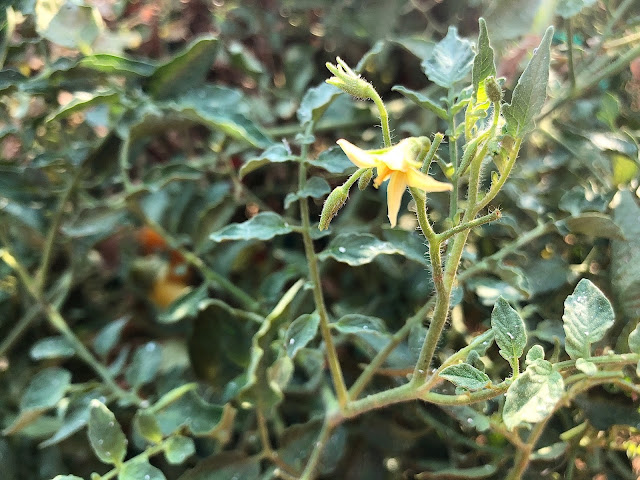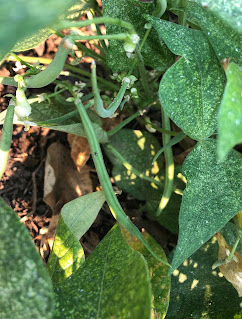
|
|
This Juliet tomato still is producing plenty of flowers. It's surprisingly heat-resistant. (Photos: Kathy Morrison)
|
The summer vegetable garden that looked so lovely, so full of potential in May is showing its age, ragged and browning.
Our current heat wave is certainly among the reasons. (Peak of 112 degrees, are you kidding me?) But even in “normal” years, by mid to late August the gardener faces that big question with each crop: Is it time to pull the plants out?
Each garden is different, as is each gardener’s patience. But to get you thinking, here are three reasons to fetch the shovel and four to stand pat (with maybe a little extra watering the rest of the month).
Dig it up if:
-- The plant no longer is producing new shoots. Don't worry about lack of flowers. It’s been too hot for most vegetable flowers; that’s something the plant avoids or discards as a stress inducer in weather like we’ve been having. But if some of the plant is yellow or brown, yet it’s been getting regular watering, look all over it for small hints of new growth. If you see nothing new AT ALL on the plant, it’s probably time to pull it. And some vegetables, like corn and determinate tomatoes, likely are done anyway.

|
|
Time to pick these last bush beans and pull
the plant, which has mite damage.
|
-- It’s under attack from a disease or a pest that’s affecting production. A bit of leaf miner damage will not prevent a pepper’s fruit from growing, for example, but a serious spider mite infestation can limit a plant’s ability to photosynthesize. Pull and toss it in the trash, not the compost bin. At this point in the year, trying to halt the attacker might be costlier (in time or products) than any remaining crop would be worth.
-- You’re tired of it. OK, you’ve had enough zucchini to last you till next summer. A perfectly valid reason, especially if you want to use that space for a fall/winter crop. Just be sure to enrich the soil again (preferably with compost) so your next crop gets off to a good start.
You can let it be (for now) if:
-- It was planted late and didn’t produce much before the heat hit. If the plant has vigor, even if very little fruit, leaving it in place into the fall could produce a late crop when the temps are a bit lower. I found this to be true one year with
a Black Plum tomato I was ready to give up on
.
-- It’s still producing flowers, even in the heat. This plant may be heat-resistant, even if it was never advertised as such. Lucky you! Make a note on that for next year, too. In my garden, I’m still getting lots of flowers on the Juliet tomato, a rugged plant despite its name and always the last tomato I pull out.
-- It has the potential to overwinter if protected from frost, and you are interested in trying that. In our growing region, some small peppers can be protected and produce a crop in their second year. Cherry tomatoes have been known to survive until New Year’s with the right conditions.
-- You just aren’t sure. The plant’s just sitting there, but it’s clearly not dead. It may have gone into a temporary dormancy. If you’re interested in seeing what else it will produce, there’s no harm in leaving it there for a few more weeks. Be sure to keep watering it on the same schedule, and fertilize once the triple-digit heat stops. Good luck!


